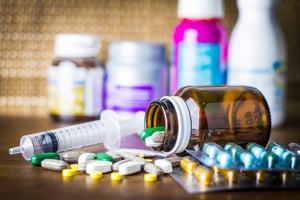Share this
antiepileptics and microsampling: TDM for AEDs is easy as ABC
by Neoteryx Microsampling on Sep 20, 2018 4:09:00 AM
 Therapeutic drug monitoring (TDM) is essential for those taking medication for the long run, such as those who use anti-epileptic drugs (AEDs). For AED monitoring, the most common method uses a liquid chromatography that is of high performance to determine the presence of anti-epileptic drugs in the human plasma. Some of the most common anti-epileptic drugs monitored through therapeutic drug monitoring include the following.
Therapeutic drug monitoring (TDM) is essential for those taking medication for the long run, such as those who use anti-epileptic drugs (AEDs). For AED monitoring, the most common method uses a liquid chromatography that is of high performance to determine the presence of anti-epileptic drugs in the human plasma. Some of the most common anti-epileptic drugs monitored through therapeutic drug monitoring include the following.
- Lamotrigine
- Oxcarbazepine
- Tiagabine
- Rufinamide
- Levetiracetam
- Zonisamide
Anti-Epileptic Therapeutic Drug Monitoring
The primary goal of AED therapeutic drug monitoring is the optimization of a patient’s clinical outcome by supporting management of the patient’s medication through measurement of drug concentration levels. Therapeutic drug monitoring has become very important in treatment with the AEDs since it can be quite difficult to identify a patient’s optimal dose on just the clinical basis. This is due to a number of reasons. Some of the reasons include:
- Clinical symptoms of toxicity are not readily detectable.
- There are no direct laboratory indicators for AED toxicity or clinical efficacy.
- The interconnection between AED serum levels and clinical effects is much better compared to that of dose and effect.
- AED treatment is purely prophylactic, and since seizures occur at irregular intervals it is hard to determine whether a prescription will be sufficient to control seizures long term.
The process of monitoring requires samples of blood from the patient and for the longest time, venipuncture has been the main technique used to obtain blood. However, this method has proven to be an invasive technique. Technological advancement has facilitated the invention of new techniques that are less invasive and allow drawing little amounts of blood compared to venipuncture.
One of these technologies is microsampling. It allows drawing very little amounts of blood (as little as 10 µL to 20 µL) which can be used for the therapeutic drug monitoring (TDM). With the amount of blood needed for these tests from time to time, it is the safest method of obtaining blood from patients without having to put the patients’ health in jeopardy. Other than that remote patient monitoring with microsampling, is an easy and convenient method of blood sample collection and can be done even in remote areas where patients can draw blood on their own and send the sample to the lab for evaluation. With microsampling, TDM for AEDs is as easy as ABC.
Share this
- Microsampling (206)
- Research, Remote Research (119)
- Venipuncture Alternative (105)
- Clinical Trials, Clinical Research (83)
- Mitra® Device (73)
- Therapeutic Drug Monitoring, TDM (51)
- Dried Blood Spot, DBS (39)
- Biomonitoring, Health, Wellness (30)
- Infectious Disease, Vaccines, COVID-19 (24)
- Blood Microsampling, Serology (23)
- Omics, Multi-Omics (21)
- Decentralized Clinical Trial (DCT) (20)
- Specimen Collection (18)
- Toxicology, Doping, Drug/Alcohol Monitoring, PEth (17)
- Skin Microsampling, Microbiopsy (14)
- hemaPEN® Device (13)
- Preclinical Research, Animal Studies (12)
- Pharmaceuticals, Drug Development (9)
- Harpera Device (7)
- Industry News, Microsampling News (5)
- Antibodies, MAbs (3)
- Company Press Release, Product Press Release (3)
- Environmental Toxins, Exposures (1)
- July 2025 (1)
- May 2025 (1)
- April 2025 (2)
- December 2024 (2)
- November 2024 (1)
- October 2024 (3)
- September 2024 (1)
- June 2024 (1)
- May 2024 (1)
- April 2024 (4)
- March 2024 (1)
- February 2024 (2)
- January 2024 (4)
- December 2023 (3)
- November 2023 (3)
- October 2023 (3)
- September 2023 (3)
- July 2023 (3)
- June 2023 (2)
- April 2023 (2)
- March 2023 (2)
- February 2023 (2)
- January 2023 (3)
- December 2022 (2)
- November 2022 (3)
- October 2022 (4)
- September 2022 (3)
- August 2022 (5)
- July 2022 (2)
- June 2022 (2)
- May 2022 (4)
- April 2022 (3)
- March 2022 (3)
- February 2022 (4)
- January 2022 (5)
- December 2021 (3)
- November 2021 (5)
- October 2021 (3)
- September 2021 (3)
- August 2021 (4)
- July 2021 (4)
- June 2021 (4)
- May 2021 (4)
- April 2021 (3)
- March 2021 (5)
- February 2021 (4)
- January 2021 (4)
- December 2020 (3)
- November 2020 (5)
- October 2020 (4)
- September 2020 (3)
- August 2020 (3)
- July 2020 (6)
- June 2020 (4)
- May 2020 (4)
- April 2020 (3)
- March 2020 (6)
- February 2020 (3)
- January 2020 (4)
- December 2019 (5)
- November 2019 (4)
- October 2019 (2)
- September 2019 (4)
- August 2019 (4)
- July 2019 (3)
- June 2019 (7)
- May 2019 (6)
- April 2019 (5)
- March 2019 (6)
- February 2019 (5)
- January 2019 (8)
- December 2018 (3)
- November 2018 (4)
- October 2018 (7)
- September 2018 (6)
- August 2018 (5)
- July 2018 (8)
- June 2018 (6)
- May 2018 (5)
- April 2018 (6)
- March 2018 (4)
- February 2018 (6)
- January 2018 (4)
- December 2017 (2)
- November 2017 (3)
- October 2017 (2)
- September 2017 (4)
- August 2017 (2)
- July 2017 (4)
- June 2017 (5)
- May 2017 (6)
- April 2017 (6)
- March 2017 (5)
- February 2017 (4)
- January 2017 (1)
- July 2016 (3)
- May 2016 (1)
- April 2016 (2)



No Comments Yet
Let us know what you think